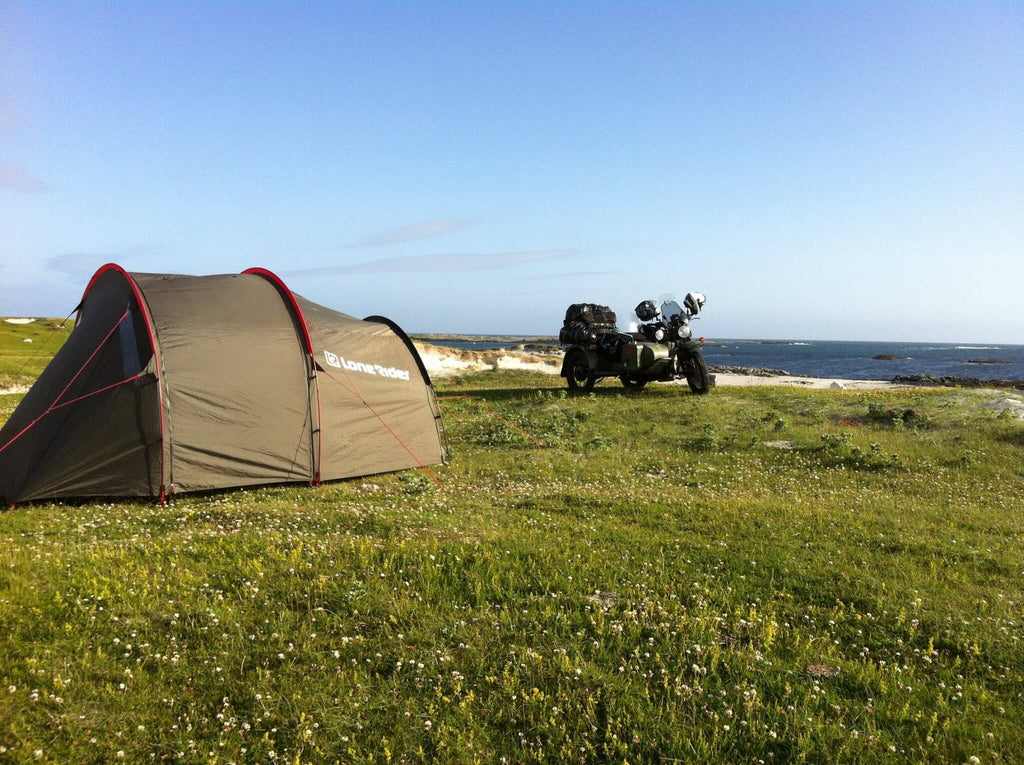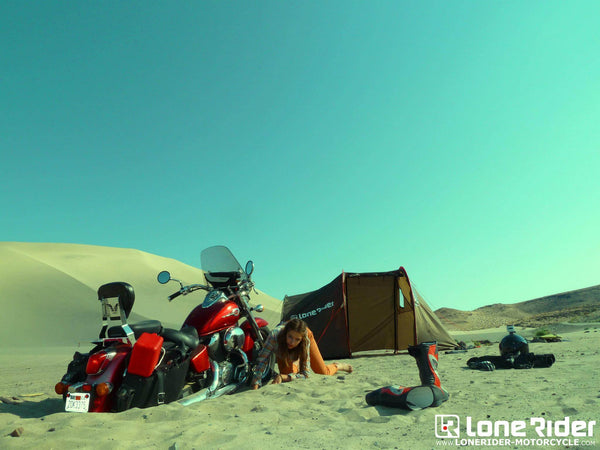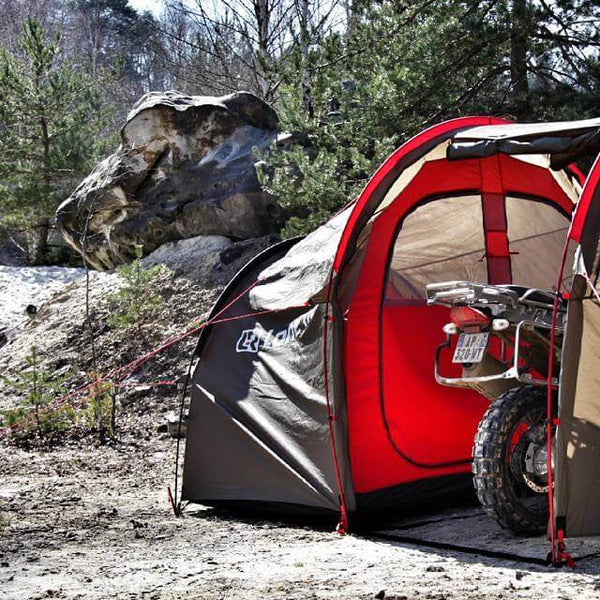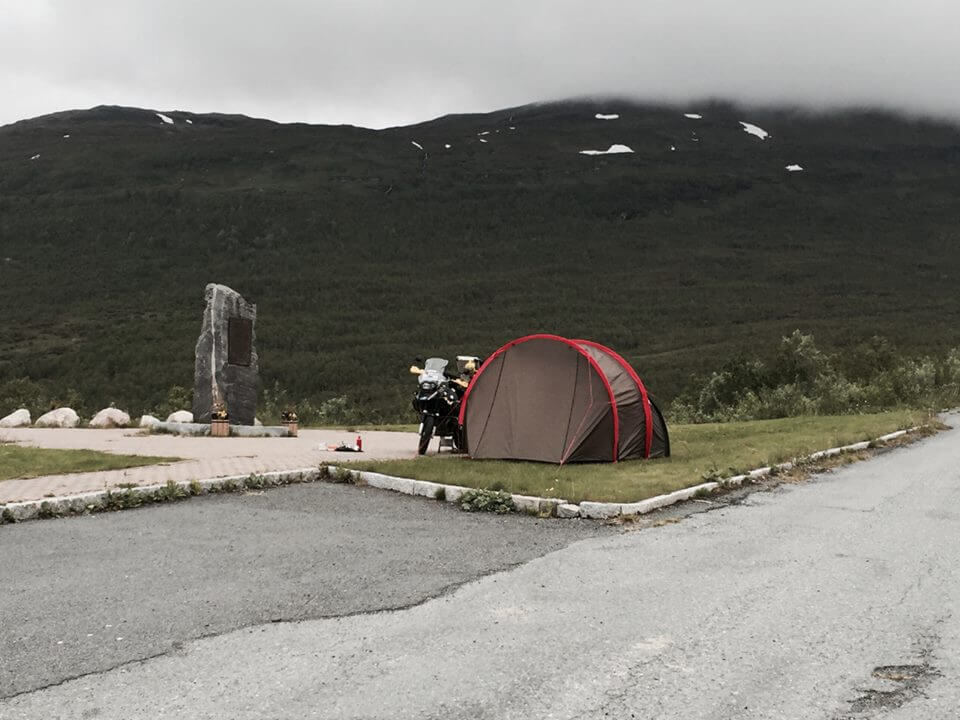Top 20 Riding & Camping Gear Tips for ADV Motorcyclists

20 Riding & Camping Gear Tips
Serious adventure motorcycling means you are not going to stay on the pavement for extended periods of time. In some cases, it may mean you’ll be rolling out some serious miles far off the beaten path and over some rugged terrain, along with some camping. Preparation under those conditions is key not only to enjoying your saddle time, it could even be important to your health and safety. With that in mind, we offer tips on gear for you and your bike.
- Hydration
Whether you anticipate hot and dry, or cold and damp, weather conditions, keeping your body well-hydrated is absolutely crucial. Keeping the location of water sources along the way in mind and having plenty of water with you is a vital strategy. Camel packs, bladder-style canteens, water filtration straws and simple water bottles are all gear that can help keep us hydrated.
- Human Fix-It Kit (aka: First Aid Kit)
We all bring along the tools and gear to fix our bikes on the trail, but more importantly we should remember to bring along a well-designed First Aid kit, along with the First Aid training to use it.
- Nutrition
Planning your menu for simplicity and nutrient value is crucial to keeping your energy level up for those long treks into the backcountry. Freeze-dried and other instant-prepared foods are light compact and can be high in nutrients, but it’s also great to pack some “real” food to cook or eat fresh on the trail.
- Food Prep Gear
A compact gas or Sterno camp stove can make a hot meal easier even in wet, cold weather when dry campfire wood is hard to come by. Having a fire-starter flint or steel can come in handy, as well, though a good old windproof butane lighter is very handy, as well.

- Lightweight Tent
Modern tents like the MiniTent can be ultralight, super tough and surprisingly spacious and easy to set up. While the idea of “sleeping under the stars” has a certain roughing-it appeal, when you want the full comforts of home, or the weather turns damp and chilly—or even frosty—a tent such as the MotoTent is home sweet home. Good ground cover in the form an inflatable air mattress or closed-cell foam pad can make the difference between getting a good night’s sleep—and not.
- Lightweight Sleeping Bag
The ultimate weapon in the search for comfortable, restful sleep out on the trail is a good sleeping bag. Using layered approaches for both the sleeping bag and your riding gear provides versatility in terms of being able to easily adjust for all temperatures. For the sleeping bag, an insert that can be added when needed makes a moderate temperature bag work as one for cold temperatures.
- Power Options
Extra fully charged batteries for cell phone, camera, flashlight(s) and any other battery-operated gear is essential. If your bike has a 12v socket and you have a charger with the right plug, be sure to pack it.
- Multi-Tool that can Multi-Task
There are a myriad of multi-tools on the market and they can come in handy for bike repair and maintenance out on the trail as well as for tasks around the campsite. Some pocket-sized models even include tiny LED flashlights that throw an amazing amount of light; those can be very handy out in the wild.

- Extra Clothes in a Waterproof Duffel or Dry Bag
Whether your clothes get damp from perspiration or soaked in rain or stream crossings, it’s essential to be able to change into dry clothes. Damp clothing can be very uncomfortable and the chilling effect of evaporation can lead to hypothermia.
- Footwear is Your Foundation
Good boots are your best friend for long days on the road or trail. Waterproof boots that fit just right with a good, thick sock can protect your feet from blisters and make your walk-around time much more pleasant. If you choose boots with laces for riding as well as hiking, be sure to tuck the laces so the loops don’t get caught on the footpegs when you go to put your feet down.
- Glove Up
Good riding gloves to protect your hands from road and trail hazards and brush/limb contact are critical. Comfortable lightweight gloves for weather protection when not riding are a good thing to bring along; not all gloves that are good for riding will work well for around the camp or out on a hike. For example, riding gauntlets with armored knuckles probably aren’t the best set-up for hiking or keeping your hands warm at night.
- Be Repulsive
Be repulsive to bugs, that is. Swarming insect pests can make a warm summer evening around the campfire a miserable experience; a small bottle of insect repellent can prevent that. A pump spray bottle has the advantage of allowing you to get some on your back and other hard to reach areas of clothing more easily than lotion in a bottle that must be applied by hand.

- Layer Up
Being prepared to add or subtract layers of clothes as needed for changing temperatures is a great strategy for staying comfortable come what may. Light base layer items are available in a variety of styles and materials that work well with moderate and heavier over layers to meet weather conditions across the temperature range.
- Spare Parts
Modern adventure bikes are built to be very robust and reliable, but that’s not the same as unbreakable. For example, for bikes with chain final drive, carrying a master link and chain repair tool for repairs on the trail is a good idea.
- No Short Fuse
Don’t forget to pack extra fuses of each amperage your bike takes—and be sure they are the right style to fit the fuse block. While a blown fuse can sometimes “just happen” and replacing the blown fuse is all that needs to be done, it’s a good idea to try to troubleshoot what caused the fuse to fail. Look for spots where a wire in the affected circuit has cracked or abraded insulation that can short out against the frame or engine. That can prevent your only extra fuse from immediately being blown when you replace it.
- Tape It Up
A roll of electrical tape is handy for repairing broken wire insulation as in the situation above, as well as potential repairs on fabric and vinyl items. The range of uses for so-called “duct tape” is the stuff of legend and taking a small roll along can be very handy.

- Spark Your Trip
Modern motorcycle spark plugs are designed to give many miles of reliable performance, but the simple truth is that sometimes even a brand-new spark plug from a tune-up you did just before the trip can fail. Having a spare, properly gapped spark plug along can be a real trip-saver.
- Pump It Up
Tires take a beating on the road and on the trail. Tough as they are, road hazards and sharp rocks can still cause a flat, even in a new tire. Carrying a tire puncture repair and inflator kit (aerosol canned inflators are generally not recommended for motorcycle tires, so check before you buy them) can be a real time-saver.
- Tied Up
A length of climbing (kernmantle) style rope, a couple of extra bungee cords and an extra cargo strap or two can be very helpful in getting and keeping all your gear on the bike, as well as setting up camp.
- Tools Matter
Be sure to have all the tools you need for routine maintenance and repair on your bike. Match the tools you carry to your bike by making sure you have the right size wrenches and correct style screwdrivers and other drivers for the fasteners used on your bike. Some have multiple types; flat blade, Phillips, Torx, you name it. If your bike included a factory-supplied tool kit, that should be most of what you need, but think also about any equipment that may be aftermarket with other sizes and styles of fasteners. Be sure to take a correctly-sized spark plug wrench—those often are not included in standard tool kits.
These are just a few of the ideas and tips that may apply to your particular adventure bike outing. Add yours and get out there!

